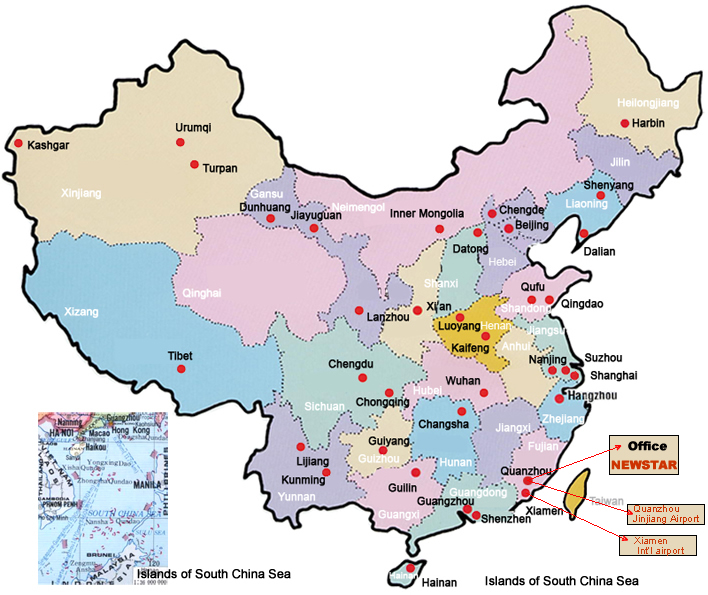(1) Flight
When you visit us, you can fly to Xiamen Int��l Airport and Quanzhou Jinjiang Airport
(2) Hotel
You can stay here Quanzhou Yeohwa Hotel is,their website is : (five Star     ) )
(3) Dining
Our Local main food have Seafood such as Crab,Shrimp etc, also have different kinds of foods from other countries!
The cuisine of the seaport city of Quanzhou has been influenced by many different cultures, some even overseas. Cooks use the local seaside provender and exotic methods to create a variety of special dishes. Among these dishes, the most famous are local appetizers. Their popularity has spread to other countries in south and east Asia. The following is a sampler of Quanzhou's more famous recipes.
Kezai Jian (Fried Oyster)
This is a traditional snack cooked with big, fleshy oysters and fresh leeks. The oysters are mixed with the leeks and sweet potato powder together with clear water and pan fried for about two minutes. Then they are sprinkled with some lard, soy and vinegar and turned over several times in the pan. Finally, the oysters are topped with a fried egg. You can add more flavors to this dish by adding shallots and pepper.
Tusun Dong (Frozen Siphon Worm)
Tusun is a kind of eatable insect about four inches long living on the sandy shores. Locals often remove the insects' haslets and boil only their outer bodies in clear water. The pectin inside the insects' bodies is then mixed with water and frozen. After freezing, the mixture takes the form of a pure white jelly. When eating the frozen jelly, you can boost its flavor by adding vinegar, sweet catsup, garlic, tomatoes or any condiment you wish.
Mianxian Hu (Noodles in Soup)
This dish is a soup that is prepared with oysters, shrimps and mussels on a slow fire. Thin noodles are then added. The dish is complete when the noodles become mushy and blend with the soup. Sometimes, mushrooms and fish fillets are added to make the dish even more tasty.
Rouzong (Pyramid-Shaped Dumplings Made of Pork)
These dumplings are made with many ingredients including not only pork and glutinous rice, but also mushrooms, chestnuts, lotus seeds, ham and chicken. The preparation is also quite complicated. First the pork is boiled with various seasonings. Then the rice is stir-fried with the both of the stewed pork. After the rice is cooked, it is mixed with the pork, chestnuts, mushrooms and other condiments in bamboo leaves. Finally, the dumplings are simmered in a big pot for about half a day. Rouzong tastes rich and sweet, but not greasy. You can add some gingili sauce or garlic if you like.
Shenhu Yuwan (Fish Pellet)
This dish is quite representative of Quanzhou cuisine. Fish pellets are made by mixing eel meat and sweet potatoes powder with egg whites. They can be formed round, rectangular or even in the shape of a fish. The pellets are boiled in water, then covered with hot chicken soup and sprinkled with peppers, garlic and coriander leaves. The pellets are snow-white and tender and have a crisp, delicate taste.
Quanzhou has more snacks worthy of tasting, such as the crisp Chunbing cake, the multi-flavored Nenbing cake, the sweet peanut kernel soup and the soft noodles with meat and gravy. Quanzhou also has a Delicious Food Street where you can enjoy all of the local snacks as well as famous dishes from other cities including Canton, Xiamen, Fuzhou, Taipei, and Singapore. Delicious Food Street is near Tumen and Jinhuai streets in the Licheng district. Many city buses go there including No. 17, 18, 19, 20, 23, 26, and 27. Of course, you can also take a taxi there.
(4) Quanzhou's Climate
The land of Quanzhou has a tropical marine climate and is influenced by the monsoon. As a result, the climate is warm and wet almost all year round with annual average temperatures of about 18 C-20 C (64 F-68 F). Therefore a visit can be made to Quanzhou any time of the year, although between April and November is probably the best period.
Tips:
* From May to June, Quanzhou often experiences frequent rainfall; so remember to take an umbrella along with you!
* Summer (July to September) in Quanzhou often lasts for a long time but temperatures are not as high as some other parts of China. The average summer temperature is about 26 C to 29 C (79 F-84 F). So bring plenty of summer clothes if you do choose this period of time to come.
* Quanzhou is very susceptible to typhoons, mostly in May, June, October and November. We recommend you use detailed weather reports available on the internet to try to avoid them.
* Although winter (December to February) is not too cold (snowfall is unlikely), cold waves do often come in February, October or November. Again, pack appropriate thick clothes if you come in winter.
Yearly Climate Info -- Quanzhou
Detailed information about the Average, Maximun and Minimum Temperatures and the rainfall in Quanzhou.
Average Data |
Jan |
Feb |
Mar |
Apr |
May |
June |

|
Average High ( F) F) |
61/64 |
60/63 |
64/67 |
71/74 |
78/82 |
83/87 |

|
Average High ( C) C) |
16/18 |
15/17 |
18/20 |
22/24 |
26/28 |
28/30 |

|
Average Low ( F) F) |
49/52 |
49/52 |
52/56 |
60/63 |
68/71 |
73/77 |

|
Average Low ( C) C) |
9/11 |
9/11 |
11/13 |
15/17 |
20/22 |
23/25 |

|
Rain (in) |
1.4/1.5 |
2.6/2.7 |
4.0/4.1 |
5.5/5.6 |
6.4/6.5 |
7.7/7.8 |

|
Rain (mm) |
35/40 |
65/70 |
100/105 |
140/145 |
160/165 |
195/200 |
Average Data |
July |
Aug |
Sep |
Oct |
Nov |
Dec |

|
Average High ( F) F) |
88/92 |
88/92 |
86/89 |
80/84 |
73/76 |
65/69 |

|
Average High ( C) C) |
31/33 |
31/33 |
30/32 |
27/29 |
23/25 |
19/21 |

|
Average Low ( F) F) |
77/80 |
76/80 |
74/78 |
68/71 |
60/64 |
53/56 |

|
Average Low ( C) C) |
25/27 |
25/27 |
23/25 |
20/22 |
16/18 |
12/14 |

|
Rain (in) |
5.1/5.2 |
5.7/5.8 |
4.0/4.1 |
1.0/1.1 |
1.5/1.6 |
0.8/0.9 |

|
Rain (mm) |
130/135 |
145/150 |
100/105 |
25/30 |
35/40 |
20/25 |
|
(5) Quanzhou Travel Guide
Quanzhou, also called Licheng and Citong Cheng in Pinyin, is one of the most famous historical and cultural cities in China. It is an important seaport located in southeast Fujian Province and is the economic and political center of the province. To its east is Taiwan separated from Quanzhou by the East Sea, making Quanzhou the famous mother town of Chinese compatriots in Taiwan and overseas. The climate is warm and humid, comfortable for year-round travel, making Quanzhou a popular tourist destination.
Due to its special location, Quanzhou has been China's marine door to exotic cultures since ancient times. During the Song (960-1279) and Yuan (1271-1368) dynasties, Quanzhou port became one of the largest world ports. As the starting point of the Sea Silk Road, it accepted diverse religions including Christianity, Islam and Manichaeism. Today it is called 'World Religions Museum'. Here exotic cultures have been mixed with traditional ones for thousands of years, leaving many historic sites, such as Qingjing Mosque, the Islamic Saint Mausoleums, Kaiyuan Temple, Tianhou Palace and other architectural classics such as Luoyang Bridge, Anping Bridge and Chongwu Ancient Town. Zheng Chenggong (1624-1662), the national hero who helped the government regain Taiwan from Holland in the 17th century, was also born here. His mausoleum in Nan'an city has become a precious historical site in Quanzhou.
In addition to places of historical interest, Quanzhou also abounds in natural beauties including various mountains, river valleys and basins. The famous mountains include Mt. Qingyuan, Mt. Zimao, Mt. Xiangong, Mt. Lingxiu and Mt. Penglai, where the Qingshui Yan temple is situated. Recreational parks near the mountains and along the sea add modern atmosphere to the city's glamour.
Quanzhou has a large variety of local dining including snacks such as fried oysters, frozen siphon worms, noodles in meat soup and fish pellets. If you are interested in Chinese tea, do not miss Wulong Tea in Anxi County. Clever in art, Quanzhou people have created many folk operas including Nanyin, Gaojia Xi, Liyuan Xi and Marionette Show.
In Quanzhou, there are hotels of different standards as well as small hostels. If you are a backpacker, the hostels near the new long distance bus station along Wenling Road are very good choices. Quanzhou also has many commercial streets for shopping, such as the Back City Street (Houcheng Street), Zhuangyuan Street, Zhongshan Road and Daxi Street.
Nightlife in Quanzhou is colorful. Local people often enjoy the delicious food in the night market; fly kites in the squares or boat in park lakes. Young people usually go to the caf��s, bars and clubs, chattering, singing and dancing; while seniors often go to cinemas or theaters to see local operas. Office workers choose beauty parlors or gymnasiums for relaxation.
Quanzhou has convenient transportation facilities. Jinjiang Airport supports flights not only to many cities of inland China but also to Hong Kong and Manila. Quanzhou railways reach most cities in Fujian as well as cities in several neighboring provinces. Highways are also well developed in the city, offering convenient access to Xiamen and Fuzhou. In addition, Quanzhou, a seaport city, offers access by water to and from many cities of China, including Dalian, Shanghai, and Hong Kong. |








